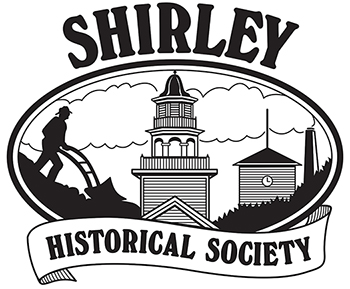First Parish Meetinghouse, on the Common, Shirley Center
For information on upcoming events or prices of renting the building, go to www.shirleymeetinghouse.org
For the history of the building – read on.
In the early days of New England, towns were formed around church centers. Town taxes paid for the upkeep of the minister. One of the reason’s for Shirley separating form Groton was that it was too far to go to church. Shirley’s first Meetinghouse was a simple one located off Parker Road. As the town grew, however, the small building was not adequate.
In 1773 the original 40′ X 50′ section of the First Parish was built in the middle of the Common where the Civil War statue now stands. The first Bible in the church was given by John Hancock’s aunt. In 1804 the bell tower was added. Later two porches and a belfry were constructed. Wallis Little gave the first bell which was replaced after 1865. A ball violin was the first instrument used in the Meetinghouse.
During the 1770’s, the Rev. Phineas Whitney helped the newborn church to grow. In the 1800’s it was primarily Seth Chandler who was the guiding spirit. Plaques honoring these two men may be found at the front of the Meetinghouse.
In the early 1800’s, there were divisions in churches all over New England. The newly won independence in matters of government was reflected in a movement for independent thoughts regarding religion. The Believers in the Second Appearing of Christ (Shakers) had already withdrawn from the town supported church. In 1822 the Congregationalists withdrew, leaving the Unitarians in the Meetinghouse. Later the town was to have more separations as Universalists and Baptists formed their own congregations and erected new buildings.
In 1939 the Meetinghouse was renovated after selling shares in the new pews. The communion table and chairs and choir cushions were added at this time.
In 1847, through the generosity of Mrs. Henrietta Whitney, a Stevens tracker organ was brought from Cambridge by ox-cart, to “be used in aid of church music.” Kate Hazen’s father, Dana Bancroft, played that organ for 49 years. Although its location has been changed slightly, it is the same organ in use today. One may still look around the corner and see where the boys would sit to pump the bellows by hand.
In a related event, in that same year, money was donated to the town for the construction of a Town Hall, to be located in the Common area.
In 1851 the Meetinghouse was moved out of the center of the Common and and over to the side on a newly dug cellar. This was accomplished by many men and several teams of oxen. The purpose of the move was to open up the center of the Common for larger gatherings and activities. This also provided a better view of both the Meetinghouse and the Town Hall.
In 1857, J. K. Going gave a set of new windows to the First Parish. Around 1884 the building was painted gray, two furnaces were installed, and a piano was given to the church by Betsy Hazen. In 1893 the roof was slated. Electric lights were installed in 1930. Although a cellar privy has been used from time to time, the building still lacks running water and toilet facilities, Visitors must use those at the neighboring Town Hall.
In the early 1900’s there was a variety of preachers and fund raising events by the diminishing congregation. A Catholic church and an Episcopal chapel had now been built in the town. By the 1940’s, the Unitarians disappeared and there has not been any religious sect associated with the church since that time.
In November of 1944, Dr. Clifford Shipton, who was concerned about the preservation of the Meetinghouse, initiated a meeting out of which came the organization known as the First Parish of Shirley. Since its founding, members of the First Parish have been concerned about maintaining the Meetinghouse as an important historic structure and focal point of our New England community. One may become a member of the First Parish by simply “signing the book.”
In recent years the town’s annual Memorial Day Sunday Service has been held at the Meetinghouse. The Meetinghouse is also available to be used for weddings, funerals, musicals, and historic and dramatic programs.
Money raised by the First Parish organization has been used to repair roof leaks, replace broken panes of glass, and re-paint the building approximately once every decade. In the late 1970’s and early 1980’s, the steeple was repaired, and Melvin Longley Sr. repainted the interior of the building. Ruth Flagler donated the chandelier at that time. In 1997 the large pulpit and high steps at the front of the sanctuary were removed to provide more space for services and performances. Thanks to many generous donations, a baby grand piano was purchased in 1998.
Hallmark cards once used a photo of the Meetinghouse on a set of Christmas cards. It is truly a beautiful building with a rich history, and, God willing, a long and fruitful future.
Information, organized by Meredith Marcinkewicz, was based on research done by Louise Longley of the Shirley Historical Society. For further information on the history of the building, contact the Shirley Historical Society.
